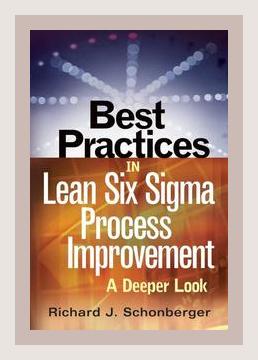Operations and Supply Chain ManagementSupply Chain Optimization
Introduction
“Best Practices in Lean Six Sigma Process Improvement” by Richard J. Schonberger falls within the category of supply chain optimization. The book focuses on enhancing business processes through the integrated approach of Lean and Six Sigma methodologies. Lean aims at waste reduction, while Six Sigma focuses on minimizing variability and defects. This synergy leads to more efficient operations and improved quality across various sectors. Here’s a structured summary highlighting the critical points and actionable practices derived from the book, each supported by concrete examples.
Chapter 1: The Evolution of Lean Six Sigma
Key Points:
- Historical Context and Synergy:
- Originates from Toyota Production System (Lean) and Motorola’s quality management (Six Sigma).
- Lean focuses on speed, efficiency, and waste reduction.
- Six Sigma targets defect reduction and process variability.
Actionable Practice:
- Implement Integrated Training Programs:
Train employees on both Lean and Six Sigma tools to foster a holistic approach to process improvement. For instance, set up workshops to teach value stream mapping (Lean) and DMAIC (Define, Measure, Analyze, Improve, Control) methodology (Six Sigma).
Chapter 2: Lean Tools and Techniques
Key Points:
- Value Stream Mapping (VSM):
-
A visualization tool to identify waste and outline steps in a process.
-
5S Framework:
-
Sort, Set in order, Shine, Standardize, Sustain for workplace organization.
-
Kaizen:
- Continuous improvement through small, incremental changes.
Actionable Practice:
- Conduct VSM Sessions: Utilize VSM to map current processes. Identify non-value-added steps. For example, a manufacturing plant reduced lead time by mapping its door assembly process and eliminating steps that didn’t add value.
Chapter 3: Six Sigma Tools and Techniques
Key Points:
- DMAIC Framework:
-
Structured problem-solving methodology.
-
Statistical Process Control (SPC):
-
Using statistical methods to monitor and control processes.
-
Failure Modes and Effects Analysis (FMEA):
- Proactive approach to identify potential failure points and their impact.
Actionable Practice:
- Implement DMAIC Approach: Select a critical issue (e.g., high defect rate in production), and apply the DMAIC framework. A company, for instance, reduced defects in their electronics line by half by rigorously following the DMAIC steps.
Chapter 4: Combining Lean and Six Sigma
Key Points:
- Integrated Approach Benefits:
-
Combining the waste-reduction focus of Lean with the defect reduction of Six Sigma for robust process improvement.
-
Holistic Performance Metrics:
- Using a balanced scorecard to measure both efficiency and quality.
Actionable Practice:
- Blend Lean and Six Sigma Projects: Initiate a project that focuses on speed and quality, such as reducing the cycle time while ensuring zero defects in customer order processing. A real-life example includes a textile company improving both their lead times and product quality by integrating 5S with SPC.
Chapter 5: Case Studies and Success Stories
Key Points:
- Toyota’s Production System:
-
Famous for Just-In-Time (JIT) and Jidoka (automation with a human touch).
-
GE’s Six Sigma Journey:
- Focused on reducing defects and variability, leading to billions in savings.
Actionable Practice:
- Learn from Exemplars: Study detailed case studies of successful Lean Six Sigma implementations. For instance, a deep dive into GE’s success can guide designing a defect-reduction initiative for a company.
Chapter 6: Common Challenges and Pitfalls
Key Points:
- Cultural Resistance:
-
Employees may resist change due to comfort with current practices.
-
Silo Mentality:
-
Departments operating independently without collaboration.
-
Insufficient Training:
- Lack of proper training stalling improvement efforts.
Actionable Practice:
- Foster a Culture of Continuous Improvement: Use change management strategies, such as involving employees in decision-making, and provide comprehensive training sessions. A manufacturing firm encouraged cross-functional team projects to break silos and promote a unified improvement culture.
Chapter 7: Sustaining Improvements
Key Points:
- Standard Work:
-
Establishing documented, standardized procedures to maintain consistency.
-
Continuous Monitoring:
- Regularly reviewing processes to ensure sustained improvements.
Actionable Practice:
- Standardize Processes: Develop and enforce standard operating procedures (SOPs). Regular audits, such as monthly process reviews, helped a logistics firm maintain high delivery accuracy standards.
Chapter 8: Lean Six Sigma in Supply Chain Optimization
Key Points:
- Lean Logistics:
-
Streamlining logistics to reduce waste and improve speed.
-
Supplier Quality Management:
- Collaborating with suppliers to ensure quality inputs.
Actionable Practice:
- Optimize Inventory Levels: Apply Lean principles to inventory management, such as implementing JIT to reduce holding costs and avoid obsolescence. A global retailer decreased inventory costs significantly by using Kanban systems for inventory control.
Chapter 9: Metrics and Performance Measurement
Key Points:
- Key Performance Indicators (KPIs):
-
Using metrics like cycle time, defect rates, and customer satisfaction to gauge performance.
-
Balanced Scorecard:
- A more comprehensive approach combining financial, customer, operational, and people metrics.
Actionable Practice:
- Develop Balanced Scorecards: Create a balanced scorecard tailored to your business needs. Include KPIs that reflect efficiency, quality, and customer satisfaction. A financial services company used a balanced scorecard to improve overall service delivery performance.
Chapter 10: Future of Lean Six Sigma
Key Points:
- Technological Integration:
-
Incorporating AI and IoT in Lean Six Sigma for predictive analytics and process automation.
-
Sustainability and Green Lean:
- Focusing on sustainable practices that reduce environmental waste.
Actionable Practice:
- Leverage Technology: Integrate AI tools for predictive maintenance in manufacturing operations. A car manufacturer used IoT sensors to monitor machinery, preemptively addressing issues before they caused downtime, thus optimizing maintenance schedules.
Conclusion
Richard J. Schonberger’s “Best Practices in Lean Six Sigma Process Improvement” provides a comprehensive guide to optimizing business processes. Key takeaways include integrating Lean’s waste-elimination with Six Sigma’s quality-focus, adopting standardized practices, overcoming cultural barriers, and continuously improving and monitoring processes. Companies can benefit considerably by adapting these practices into their operations, thus driving efficiency, quality, and overall performance in their supply chains.
Operations and Supply Chain ManagementSupply Chain Optimization
